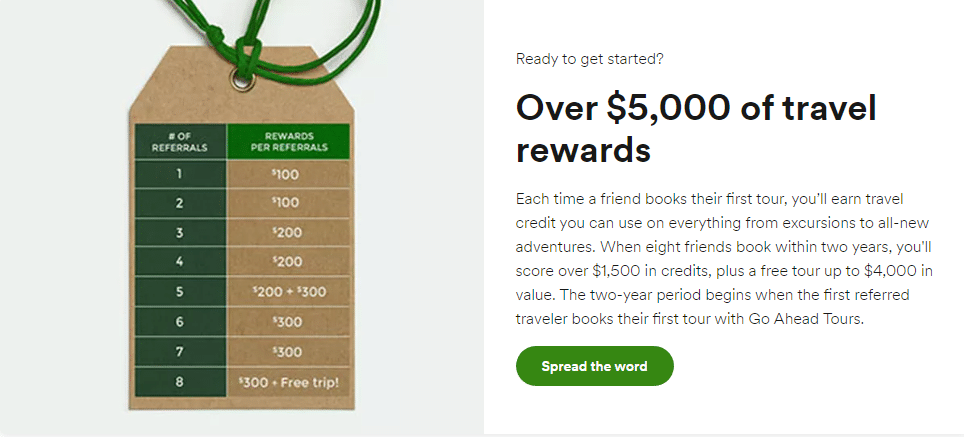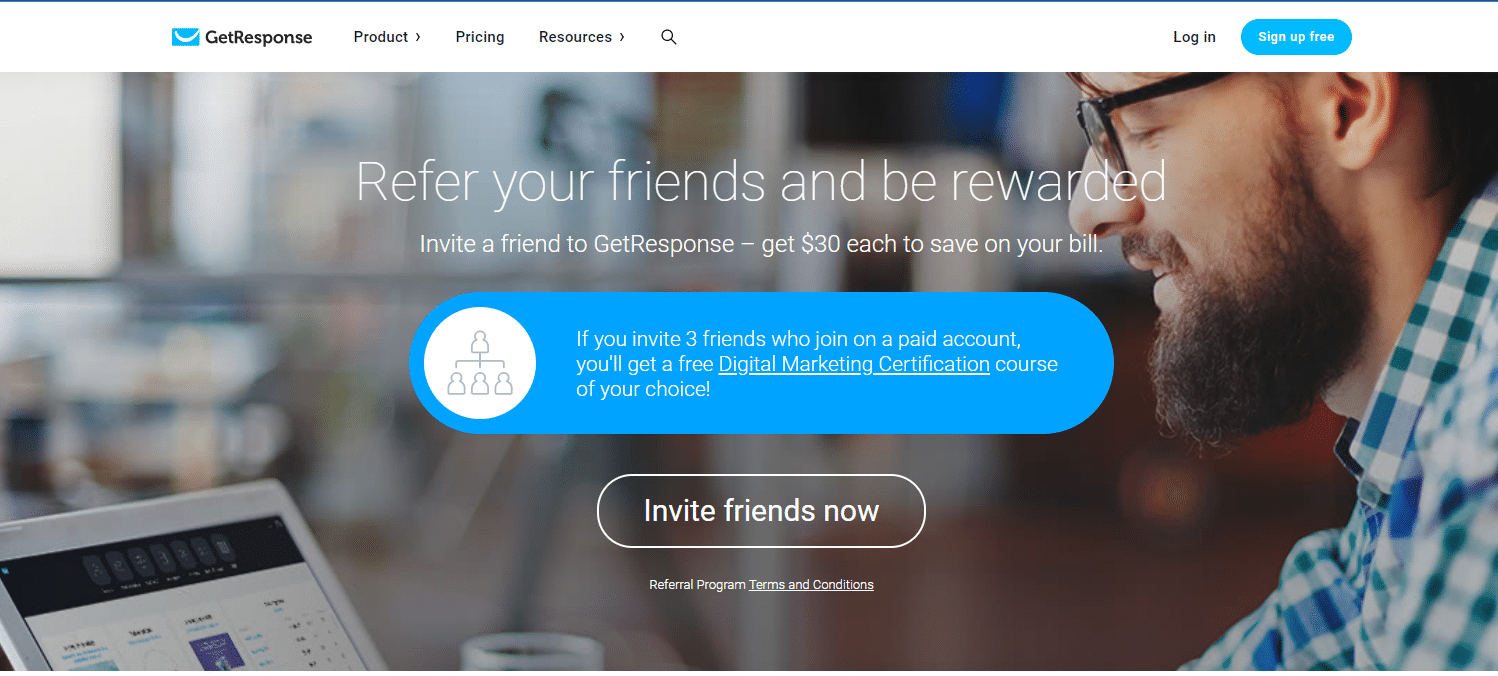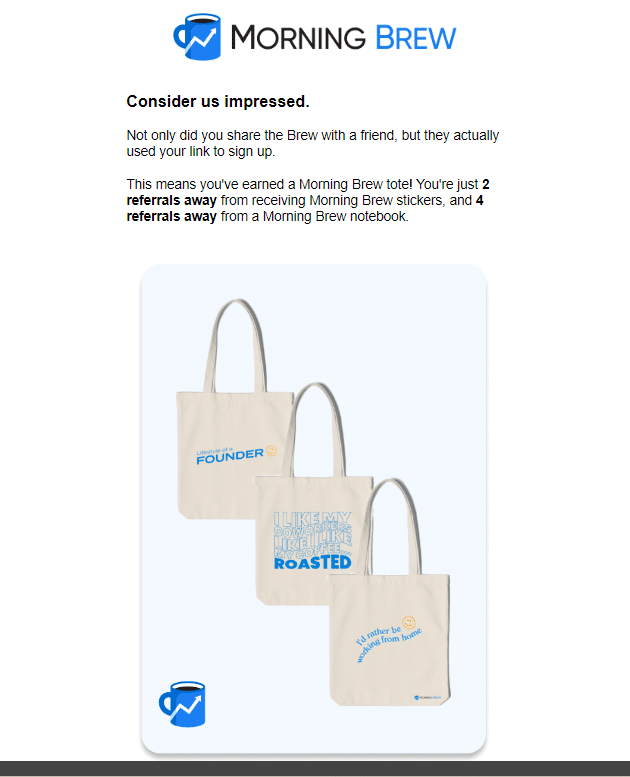Planning on starting a referral program and wondering about the best ways to motivate repeat referrals? Or, looking for a way to shake up your reward structure and create more prolific advocates? One option is a milestone referral program, also called a tiered referral program.
What is a milestone referral program, and how does it work? What tips do you need to know when starting one? We’ll cover all you need to know in this guide.
What is a milestone referral program?
A milestone referral program (or a tiered referral program) offers different levels of rewards to motivate your customers, subscribers, or employees to make more referrals. Every time someone reaches a set number of lifetime referrals, they earn a new referral reward. And the more successful referrals someone makes, the higher the value of the rewards that the referrer earns.
For instance:
- Referral #1 = 20% discount off of their next purchase
- Referral #3 = a free product
- Referral #5 = $100 in store credits
A successful referral means that someone referred a friend who made a purchase, subscribed to your newsletter, or subscribed to your service. Basically, it’s any referral that results in the conversion you want to motivate through the program.
When to use a tiered referral program?
Milestone rewards tend to work best for businesses with high sales volumes, especially those where it’s likely that one referrer will make several successful referrals. They’re also a great fit for businesses that want to offer more unique one-off rewards.
Newsletters often use milestone referral programs to grow their subscriber bases. Two of the most successful referral programs ever are the Morning Brew and The Hustle newsletter referral programs – and both use a milestone structure.
That said, tiered referral programs can work well for businesses in any industry, as long as the business sets the tiered rewards strategically, and can afford to pay out these multiple rewards. We’ve seen tiered referral programs used by SaaS providers, travel agencies, ecommerce sites, and more.
Milestone referral program examples
As we mentioned above, one prime example of a tiered referral program is the Morning Brew referral program. This program currently has ten milestones: one successful referral earns someone a branded tote bag, three successful referrals earns them stickers, and so on – all the way up to a work-from-home makeover for anyone who successfully refers 1,000 friends to the newsletter.
Another example of a milestone structure is GetResponse’s referral program. Every time someone makes a successful referral, they earn $30 in credit towards their next GetResponse bill. But for every three referrals they make, they can take one of GetResponse’s courses for free – and these courses are valued at $200 apiece.
Why do tiered referral programs work?
Why should you consider a tiered referral program?
Since the reward values increase as someone makes more referrals, milestone rewards encourage members to send multiple referrals and stay active in your program. So, they help keep program engagement high, and could create super advocates.
Here are more details on why you should try out this program format:
Leverages the power of trust
With any referral program, including a tiered one, you’ll enjoy the benefits of the trust people put in their peers. 92% of people trust their peers’ recommendations more than any other form of advertising. Plus, referred friends are more likely to stay loyal to your business, and have a higher average lifetime value than non-referred customers. They’re also highly likely to refer their own friends, especially given the rewards you’re offering.
Encourages repeat referrals
Continued rewards are one main reason people will keep sharing a business via referral programs. With a tiered program, rewards not only stay available, but increase as the number of referrals increases – providing even more reasons for customers to keep sharing.
Increases engagement
Encouraging repeat referrals makes it more likely that customers will stay engaged with your business and its referral program. Tiered referral programs create a constant reason for customers to stay engaged, as repeat referrals result in increasingly higher rewards. This adds a gamified element that;s sure to get people excited.
Plus, by sending an email every time someone reaches a milestone and encouraging them to go for the next reward, you can boost your engagement even more.
Motivates social sharing
Social media sharing and tiered referral programs go hand in hand. Social media referrals are arguably the best type of referral, as one social share of a referral link can reach hundreds or even thousands of eyes at once. And since one social share could lead to many successful referrals, this means someone could advance through multiple tiers relatively quickly. The tiered reward structure will motivate more customers to share their referral link on social media.
Creates super-advocates
If you offer significant value rewards for high amounts of referrals, this can create situations where one advocate sends in tens, hundreds, or even a thousand referrals. That motivation can create super-advocates who become reliable ambassadors for your business, and who end up sharing on a viral scale.
That’s especially true if you go big like Morning Brew and The Hustle do. To earn their top-tier rewards, someone must make 1,000 referrals – and people have achieved those rewards before.
After you’ve created – and easily identified – these super-advocates, you might ask these customers to represent your brand more formally. For instance, you might ask them to be affiliates or brand ambassadors.
Designing your referral program tiers
Now that you know how tiered referral programs work, and you’ve seen some examples, how should you determine your tiered rewards? Here are some guidelines.
Setting up the tiers
If you’re going to design a tiered referral reward system, you’ll need to consider two factors when deciding on your tiered spacing: the reward at stake and how achievable the reward is.
Tiers should feel attainable at first, with a gap of only one to a few referrals between each tier of rewards. This is key in motivating continued referrals.
Take a cue from Morning Brew: the majority of their tiers are spaced at an achievable rate. If you refer five people, referring two more to earn another reward doesn’t seem overly daunting. The reward seems within reach, and it’s something the referrer actually wants.
As referral amounts get significantly higher, it’s ok to have very large gaps between tiers, just as Morning Brew does. For instance, it’s fine to give a reward at 100 referrals and then have the next (and final) tier reward be at 500 or 1,000 rewards.
Settling on the highest tier
Also, remember that a tiered referral program has to end somewhere – there has to be a highest tier.
If you’re a newsletter or other free content subscription, it’s best for that tier to be in the hundreds of referrals.
If you’re purchase-based and purchases are frequent, you might have a super-advocate final tier between 50 and hundreds of referrals.
But if purchases are infrequent, a final tier between five and 20 referrals may make more sense. You could also continue to give a high-tiered reward in cash – or credits – after every subsequent set number of referrals someone makes. Or, you could have tiers reset every year or every two years.
No matter what tiers and rewards you choose, make sure that they’re all motivating to your referrers. Incentives should all be items that your advocates truly want to earn, and that will be useful or meaningful to them.
Rewards for the first tier(s)
The first tier (or first few tiers) should offer motivating rewards that are attainable, but that are inexpensive for you to give out frequently. The goal here is to make the lowest tiers the most affordable, as these are easiest to reach and must be given out the most.
This might mean awarding swag bought in bulk if you’re a free content subscription business, and a small but still motivating amount of store credits (or a smaller free product) if you’re purchase based.
Especially if you’re a free newsletter, keeping the reward cost low is key.
- Morning Brew’s sticker rewards cost just 25 cents each to reward.
- Other lower-tier incentives (the notebooks and totes) are bought in large bulk amounts as well, so they’re also very affordable for Morning Brew to award.
For purchase-based businesses, be sure that the first tier(s) of rewards tie back to your business. The reward costs will ultimately be lower when the reward encourages customers to put money right back into your business.
- Store credits are overwhelmingly your best bet here.
- But small free products might also encourage your customers to buy more.
Rewards for the middle tiers
Middle tiers should be worth more than the first tiers, but still be cost-effective to pay out based on the number of customers or subscribers brought in. Again, each middle tier should be worth more than the last. Higher-value swag, credits, or free products are great options.
- For instance, if the lower-tier reward is shave cream, a middle-tier reward could be a shave set.
- Or, if a lower-tier reward is a notebook, a middle-tier reward could be a Yeti tumbler or Columbia fleece.
Rewards for the highest tier
The highest super-advocate reward should be extremely valuable. Regardless of your business type, it must reflect the value of all the customers or subscribers the top referrer brought in.
This could be:
- A tech package
- Travel credits
- An exclusive VIP experience
- A personal and expensive gift basket
- A significant amount of store credits or subscription credits
- An entirely free service
- Several free subscription months
This gives the best advocates something to shoot for.
More best practices for tiered referral programs
Now that you’ve picked out your milestone rewards, check out these other best practices for setting up your program based on pioneering tiered referral programs.
General referral program best practices still apply; we’ve covered these in our referral program ultimate guide.
Always show the referral numbers
On the referral program page, you’ll need to display the total number of referrals someone has made, front and center. After all, advocates need to know where they are in the tiered scheme so they know what they’re working towards. It’s also beneficial to display how many referrals they need to earn the next reward.
Display a progress bar
Several successful tiered referral programs have their page operate like a progress bar, with the number of referrals someone has made displayed underneath. This way, referrers can easily see the reward they’re working towards, as well as how many referrals they need to earn that next reward. When users can see these visuals, it can motivate them to keep sharing: “Oh, I only need to refer two more friends to get to the next tier.”
A progress bar may also add a gamified element, as it gives customers something they can compare with their friends (and this healthy competition could encourage even more referrals)!
Harry’s prelaunch referral program is one example of the progress bar at work.
Design your reward emails strategically
Once referrers earn a reward in your milestone referral program, you’ll likely need to send them an email so they can redeem the reward. But don’t just congratulate the referrer and give them the details needed to get the reward.
Use the email as an opportunity to “tease” the next reward and encourage them to keep referring.
Here’s a sample of text you could use in the email:
“Congratulations, you got 3 friends to sign up for the MNO Scoop Newsletter – you’ve earned an MNO Scoop tote bag! Refer just 2 more friends, and you’ll earn a pair of MNO Scoop socks!”
Choose the right software
Referral program software is key to your program’s success. It lets you create trackable referral links and monitor all of your customers’ successful referrals in real time.
But not all referral program software is capable of running a tiered referral program. Many options are only designed to run the simplest referral program structure (the “give-and-get” structure with one fixed reward).
Referral Rock referral software has everything you need to design and launch a tiered referral program in days. Set the reward tiers you want, and instantly pay out the right rewards to customers when they’re earned. Plus, send out emails to keep referrers engaged – and remind them of how many referrals they need to reach the next tier.
With Referral Rock referral software, it’s easy to both track every referral from your customers and find your best advocates at a glance. Instantly see how many referrals each customer has sent and pinpoint who has made the most referrals.
Wrapping up
A tiered referral program is an awesome way to motivate repeat referrals, but you’ll need to design your tiers with care. Make sure that tiers feel attainable, and that the incentives you offer are rewards your customers truly want to earn. And choose a referral software – like Referral Rock – that’s truly ready to handle a tiered program.









